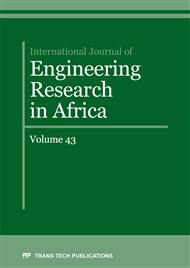p.1
p.20
p.25
p.33
p.38
p.49
p.59
p.71
p.84
The Effectiveness of Alum from some Nigerian Kaolinites in Water Treatment
Abstract:
Alum is a useful product in both leather tanning and water treatment purposes where it serves as a coagulant and disinfectant. High quality alum has recently been produced from some Nigerian kaolinite (Bauchi and Kankara) via the energy-saving process. This process utilizes the heat generated when sulfuric acid is mixed with water to dealuminate the metakaolin, instead of the usual application of external heat source. This study focuses on testing their effectiveness in actual water treatment process in comparison with a commercial alum. Several parameters of the raw water and 50 to 300 ppm of alum-raw water solution were measured to determine the effects of the alum addition. The influence of both alums was found to be strikingly similar. While the total dissolved solids (TDS) and conductivity increased with alum concentration, the biological oxygen demand (BOD), chemical oxygen demand (COD), and alkalinity of the water showed reduction. The coagulating effectiveness of both alums was demonstrated by over 95% reduction in the turbidity of the raw water sample. The results also revealed that the alum from Nigerian kaolinites showed remarkable and desirable water treatment qualities and compares well with the commercial alum for all the tested parameters. The development of alum production plant using Nigerian kaolinite is therefore recommended as it can serve as alternative to the present commercial alum that is majorly imported.
Info:
Periodical:
Pages:
33-37
Citation:
Online since:
June 2019
Authors:
Keywords:
Price:
Сopyright:
© 2019 Trans Tech Publications Ltd. All Rights Reserved
Share:
Citation:


